Genevieve as Venus at the Judgment of Paris Pas d'Armes
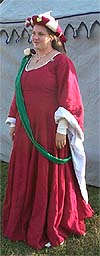 I was tasked to portray Venus as a judge of the Pas d'Armes for the Judgment of Paris. This was a very ambitious project as I was given the assignment to fill in for the former "Venus" at Pennsic (8/13/2000) and the event was scheduled for the Lochmere Baronial Birthday/Judgment of Paris (9/30/2000). Luckily I was gifted with the red linen for the over dress and had the white cotton/linen for the lining of the sleeves, and the ivory cotton/linen for the under dress in my fabric stash.
I was tasked to portray Venus as a judge of the Pas d'Armes for the Judgment of Paris. This was a very ambitious project as I was given the assignment to fill in for the former "Venus" at Pennsic (8/13/2000) and the event was scheduled for the Lochmere Baronial Birthday/Judgment of Paris (9/30/2000). Luckily I was gifted with the red linen for the over dress and had the white cotton/linen for the lining of the sleeves, and the ivory cotton/linen for the under dress in my fabric stash.
I started by researching how Venus would have been portrayed by 15th century folks and brushing up on my mythology. In the few portrayals of Venus where she was in fact dressed she had her hair down and wore a simple flowing gown of red and white. I was already given the colors of red and white to work with. The symbols that I found associated with Venus were roses, doves, swans, arrows, hearts, and often seashells (due to her birth). The symbols I chose to incorporate into my portrayal were hearts, roses, and doves. I was also told to find a companion to portray Venus's dove as my helper.

 Then I chose the type of dress that would have been appropriate for the time period we were recreating, 1400-1450, aiming for 1425. I chose to recreate one of the dresses depicted in the Tre Riches Heures of the Duke of Berry. In the May illustration (left), there is a party of revelers celebrating the pageant of the "joli mois de Mai". In the front of this excellent painting, there is a lady in a fitted green dress with long flowing sleeves riding a white mount. This was the look I wanted to create, changing the hat and the colors. While the style of the body being closely fitted was going out of fashion, several ladies in the Tre Riches Heures have the fitted scooped-necked gowns with variations on the sleeves. I also figured that a slightly older gown would still be appropriate as it was used for ceremonial purposes and I was to portray an allegorical figure.
Then I chose the type of dress that would have been appropriate for the time period we were recreating, 1400-1450, aiming for 1425. I chose to recreate one of the dresses depicted in the Tre Riches Heures of the Duke of Berry. In the May illustration (left), there is a party of revelers celebrating the pageant of the "joli mois de Mai". In the front of this excellent painting, there is a lady in a fitted green dress with long flowing sleeves riding a white mount. This was the look I wanted to create, changing the hat and the colors. While the style of the body being closely fitted was going out of fashion, several ladies in the Tre Riches Heures have the fitted scooped-necked gowns with variations on the sleeves. I also figured that a slightly older gown would still be appropriate as it was used for ceremonial purposes and I was to portray an allegorical figure.
Instead of the horned headdress, I chose to use a padded roll as seen on a few of the ladies in the April calendar illustration (pictured to the right). I made a simple white padded roll and wrapped the roll in felt dags. Later I may elaborate on the dagging and decoration. Tre Riches Heures pics taken from the Univ. of Chicago Humanities Dept.
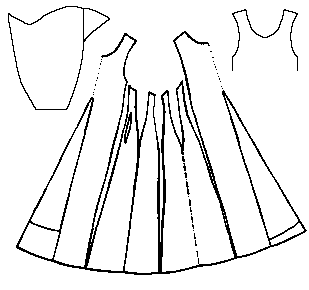 To achieve the fitted look throughout the body, I choose to use a pattern for what most Atlantians call the "cotehardie", which is the Herjolfsnes no.38 tunic with 8 fitted gores and two center front and back gores for fullness in the skirt. This can be laced or buttoned up the front to aid in achieving a closer fit.
To achieve the fitted look throughout the body, I choose to use a pattern for what most Atlantians call the "cotehardie", which is the Herjolfsnes no.38 tunic with 8 fitted gores and two center front and back gores for fullness in the skirt. This can be laced or buttoned up the front to aid in achieving a closer fit.
http://www.personal.utulsa.edu/~marc-carlson/cloth/herjol38.html
The under dress (which you only see parts of) is the traditional Herjolfsnes no.38/cotehardie with the fitted body, full, long skirt and fitted sleeves. (I must confess that I ran out of time so the sleeves were sewn closed instead of using the buttons and button holes. This will be remedied after I get the mud out of the hem.)
The over dress is made with the same body pattern, and I added large angel wing sleeves to get the Tres Riches Heures effect. I was concerned that the weight of the over dress' sleeves would drag the neckline out and down, however this was not the case due to the closeness of fit throughout the body. (I also used two decorative straight pins on each shoulder to hold the over dress to the under dress for stability and insurance.) The under dress is laced closed using hand sewn eyelets up the front from the waist to the neckline. As I saw no eyelet holes or buttons on the gown in the Tre Riches Heures, I chose instead to sew lacing rings to the inside of the over gown so that when laced, the front would look more or less like a seam.
The completed outfit consists of two dresses and a hat. The under dress is made of an ivory cotton/linen, fitted and providing a foundation and support for the over dress. The over gown of red linen has the same fitted torso as the under dress. It also features large angel wing sleeves typical of the 15th century, which were lined in a white cotton/linen damask. The hat is a padded roll made of the same ivory cotton/linen from the under dress, wrapped in red felt dags and embellished with pins and silk flowers.A few other notes on the outfit as it is displayed here.
-
 The golden apple badge pinned to the front of the padded roll is the pewter badge used to promote the Judgment of Paris event. It was cast and enameled specifically for the occasion by Master James Byngham.
The golden apple badge pinned to the front of the padded roll is the pewter badge used to promote the Judgment of Paris event. It was cast and enameled specifically for the occasion by Master James Byngham. - The white pointy thing on top of the padded roll is a cloth baronial coronet pinned in place. Venus was often portrayed Crowned, and I have my Court Baronacy in Atlantia, which allows me to wear a coronet.
-
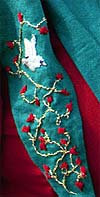 The green sash signifies Cestus, Venus's embroidered girdle. According to myth, Cestus made the wearer irresistible. I chose green to represent my apprentice belt. The embroidery on the tip of the sash (seen on my right shoulder) was done by my friend Lady Theodora two nights before the event. The embroidery is gold with red roses and a white dove (all colors and symbols associated with Venus.) I also thought that the sash helped mimic the sashes in the Tre Riches Heures and the rosary(?) draped on the lady in green.
The green sash signifies Cestus, Venus's embroidered girdle. According to myth, Cestus made the wearer irresistible. I chose green to represent my apprentice belt. The embroidery on the tip of the sash (seen on my right shoulder) was done by my friend Lady Theodora two nights before the event. The embroidery is gold with red roses and a white dove (all colors and symbols associated with Venus.) I also thought that the sash helped mimic the sashes in the Tre Riches Heures and the rosary(?) draped on the lady in green. - You may also notice an amber dolphin at my throat. This is to signify the Atlantian order of merit for service, but the dolphin was occasionally associated with Venus as well. The red and white ribbon was a last minute replacement for the chain that grabs at my hair.
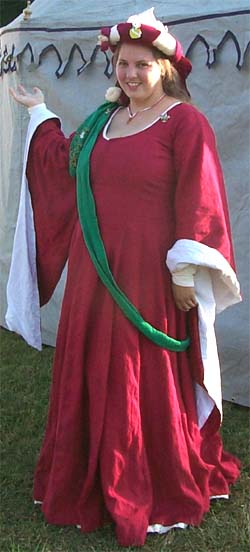 Here is a larger picture of me in the full outfit. You can see the red over dress, large sleeves, padded roll hat (wrapped in heart shaped dags), baronial coronet, and green embroidered sash. Sadly the points on the coronet sagged inwards as the stiffening I used was not sturdy enough to support the pearls on the points. The sleeves are not pinned back, but simply folded to reveal the lining (which did not photograph well.) If you look closely you can see the seams for the side fitted gores on my left hand side. The ivory under dress peeks out at the neckline, sleeves and a little at the hem.
Here is a larger picture of me in the full outfit. You can see the red over dress, large sleeves, padded roll hat (wrapped in heart shaped dags), baronial coronet, and green embroidered sash. Sadly the points on the coronet sagged inwards as the stiffening I used was not sturdy enough to support the pearls on the points. The sleeves are not pinned back, but simply folded to reveal the lining (which did not photograph well.) If you look closely you can see the seams for the side fitted gores on my left hand side. The ivory under dress peeks out at the neckline, sleeves and a little at the hem.
Below is a slightly better picture of the hat. With the dags over my left shoulder, you see that they are in fact heart shaped. (Since this was crunch time the dags are made of red felt so no edges needed finishing.) The coronet looks slightly better in this picture, but still not great. I opted for the three small silk roses in the right hand side of the hat instead of a wreath of roses around the padded roll. The golden apple badge cast and enameled by Master James Byngham is clearly viewed here.
While not a flattering shot, my eyes were closed so I figured I would use this to show other aspects of construction. Also below, you can more clearly see the side seams and the front "seam." The front is, once again, laced closed with jump rings sewn down on the inside of the front edges. A few of the jump rings escaped half of the stitches holding them in place, so I will have to experiment with alternate materials other than jump rings. I guess I could solder them closed. Anyone know where to buy just the eyes part of hooks and eyes? The fleur-de-lis pin on my left shoulder was a tourney prize my lord won for me some years ago.
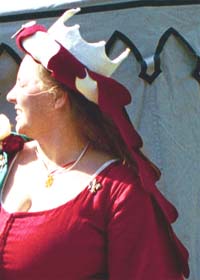
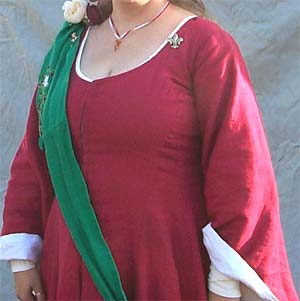
Acknowledgments: I need to thank the following for helping me get my outfit ready in time
- Baroness Alisandra for buying some materials, weaving tokens, pinning and starting my red hem, working on the hat, and lots of support.
- Lady Brighid for being my Dove and helping me in the research department.
- Honorable Lady Theodora for the embroidery upon Cestus, and loaning me Bullfinch's Mythology.
- Mistress Isobel for sewing the entire hem on my white dress.
- Lord Roland for helping with the red hem as well
Without their help this task would have truly been insurmountable.
View Pictures from the Event itself
Photographs copyright © 2000 Gwen Maxson and Melissa Petrak